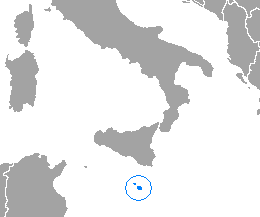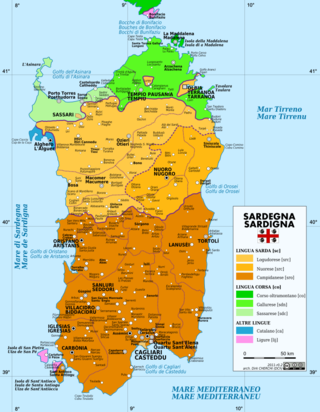
Italian is a Romance language of the Indo-European language family that evolved from the Vulgar Latin of the Roman Empire. Italian is the least divergent Romance language from Latin, together with Sardinian. Spoken by about 85 million people including 67 million native speakers (2024), Italian is an official language in Italy, San Marino, and Switzerland, and is the primary language of Vatican City. It has official minority status in Croatia and in some areas of Slovenian Istria.

Maltese is a Semitic language derived from late medieval Sicilian Arabic with Romance superstrata spoken by the Maltese people. It is the national language of Malta and the only official Semitic and Afroasiatic language of the European Union. Maltese is a Latinized variety of spoken historical Arabic through its descent from Siculo-Arabic, which developed as a Maghrebi Arabic dialect in the Emirate of Sicily between 831 and 1091. As a result of the Norman invasion of Malta and the subsequent re-Christianization of the islands, Maltese evolved independently of Classical Arabic in a gradual process of latinization. It is therefore exceptional as a variety of historical Arabic that has no diglossic relationship with Classical or Modern Standard Arabic. Maltese is thus classified separately from the 30 varieties constituting the modern Arabic macrolanguage. Maltese is also distinguished from Arabic and other Semitic languages since its morphology has been deeply influenced by Romance languages, namely Italian and Sicilian.

The Romance languages, also known as the Latin or Neo-Latin languages, are the languages that are directly descended from Vulgar Latin. They are the only extant subgroup of the Italic branch of the Indo-European language family.

Balearic is the collective name for the dialects of Catalan spoken in the Balearic Islands: mallorquí in Mallorca, eivissenc in Ibiza and menorquí in Menorca.

The Gallo-Romance branch of the Romance languages includes in the narrowest sense the langues d'oïl and Franco-Provençal. However, other definitions are far broader and variously encompass the Occitan or Occitano-Romance, Gallo-Italic or Rhaeto-Romance languages.

Sicilian is a Romance language that is spoken on the island of Sicily and its satellite islands. It belongs to the broader Extreme Southern Italian language group.
Regional Italian is any regional variety of the Italian language.
In phonetics, vowel reduction is any of various changes in the acoustic quality of vowels as a result of changes in stress, sonority, duration, loudness, articulation, or position in the word, and which are perceived as "weakening". It most often makes the vowels shorter as well.

The Gallo-Italic, Gallo-Italian, Gallo-Cisalpine or simply Cisalpine languages constitute the majority of the Romance languages of northern Italy: Piedmontese, Lombard, Emilian, Ligurian, and Romagnol. In central Italy they are spoken in the northern Marches ; in southern Italy in some language islands in Basilicata and Sicily.

Central Italian refers to the dialects of Italo-Romance spoken in the so-called Area Mediana, which covers a swathe of the central Italian peninsula. Area Mediana is also used in a narrower sense to describe the southern part, in which case the northern one may be referred to as the Area Perimediana, a distinction that will be made throughout this article. The two areas are split along a line running approximately from Rome in the southwest to Ancona in the northeast.
African Romance or African Latin is an extinct Romance language that was spoken in the various provinces of Roman Africa by the African Romans under the later Roman Empire and its various post-Roman successor states in the region, including the Vandal Kingdom, the Byzantine-administered Exarchate of Africa and the Berber Mauro-Roman Kingdom. African Romance is poorly attested as it was mainly a spoken, vernacular language. There is little doubt, however, that by the early 3rd century AD, some native provincial variety of Latin was fully established in Africa.
The Italo-Dalmatian languages, or Central Romance languages, are a group of Romance languages spoken in Italy, Corsica (France), and formerly in Dalmatia (Croatia).
Proto-Sámi is the hypothetical, reconstructed common ancestor of the Sámi languages. It is a descendant of the Proto-Uralic language.
French exhibits perhaps the most extensive phonetic changes of any of the Romance languages. Similar changes are seen in some of the northern Italian regional languages, such as Lombard or Ligurian. Most other Romance languages are significantly more conservative phonetically, with Spanish, Italian, and especially Sardinian showing the most conservatism, and Portuguese, Occitan, Catalan, and Romanian showing moderate conservatism.
As a member of the dialect continuum of Romance languages, Catalan displays linguistic features similar to those of its closest neighbors. The following features represent in some cases unique changes in the evolution of Catalan from Vulgar Latin; other features are common in other Romance-speaking areas.
In the Romance languages, metaphony was an early vowel mutation process that operated in all Romance languages to varying degrees, raising certain stressed vowels in words with a final or or a directly following. This is conceptually similar to the umlaut process characteristic of the Germanic languages. Metaphony is most extensive in the Italo-Romance languages, and applies to nearly all languages of Italy. However, it is absent from Tuscan, and hence from Standard Italian.
The dialect of Castelmezzano is a Romance variety spoken in Castelmezzano in the Province of Potenza in Italy. It constitutes a dialect of the Neapolitan language that differs from the rest in its treatment of Latin back vowels, showing an evolution more reminiscent of Eastern Romance: Latin /ŭ/ merges with /ū/ rather than with /ō/.

Sardinian is conventionally divided, mainly on phonological criteria, into three main varieties: Campidanese, Logudorese, and Nuorese. The last of these has a notably conservative phonology, compared not only to the other two varieties, but also to other Romance languages as well.
Romance linguistics is the scientific study of the Romance languages.

The Lausberg area is a part of southern Italy that covers much of Basilicata and the northern edge of Calabria, where Southern Italian dialects characterized by atypical Italo-Romance vowel developments are spoken. It is named after the German philologist Heinrich Lausberg, who brought the area to the attention of mainstream scholarship in 1939.











